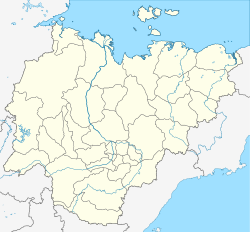Amga (rural locality)
| Amga (English) Амга (Russian) Амма (Sakha) |
|
|---|---|
| - Rural locality - Selo |
|
 Location of the Sakha (Yakutia) Republic in Russia |
|
|
|
|
|
|
|
| Administrative status (as of 2010) | |
| Country | Russia |
| Federal subject | Sakha Republic |
| Administrative district | Amginsky District |
| Rural okrug | Amginsky Rural Okrug |
| Administrative center of | Amginsky District, Amginsky Rural Okrug |
| Municipal status (as of April 2012) | |
| Municipal district | Amginsky Municipal District |
| Rural settlement | Amginsky Rural Settlement |
| Administrative center of | Amginsky Municipal District, Amginsky Rural Settlement |
| Statistics | |
| Population (2010 Census) | 6,533 inhabitants |
| Population (January 2016 est.) | 6,578 inhabitants |
| Time zone | YAKT (UTC+09:00) |
| Founded | 1652 |
| Postal code(s) | 678600 |
| Dialing code(s) | +7 41142 |
Amga (Russian: Амга́; Yakut: Амма) is a rural locality (a selo) and the administrative center of Amginsky District of the Sakha Republic, Russia, located on the Amga River. It also the only inhabited locality and the administrative center of Amginsky Rural Okrug within Amginsky District. Population: 6,533 (2010 Census);6,359 (2002 Census);5,191 (1989 Census).
The name Amga is derived from an Evenk word meaning gorge or ravine.
It was first founded by the Cossacks in 1652 as the ostrog (fortress) of Amga-Sloboda (Амга-Слобода). The first church was built in 1680, but it burned down later and was subsequently rebuilt a number of times. Agriculture has been conducted in the area since 1695; it was the first place in Yakutia used for growing crops.
Amga was a place of political exile in the Russian Empire, with the most famous exile being Vladimir Korolenko, who was exiled here for six years in 1879.
It was also the site for fighting during the Russian Civil War.
Somewhere in the area was the old river crossing of Amginsk. From about 1750 to 1850, a horse track led northwest to Yakutsk. Across the river, one route led south to Uda Bay and the other went southeast to Ust-Maya and from there south to Ayan. From perhaps 1662, there were a few Russian peasants in the area, but agriculture was usually unsuccessful. In 1737, Stepan Krasheninnikov noted that they had abandoned agriculture and were distinguishable from their Yakut neighbors only in religion.
...
Wikipedia

